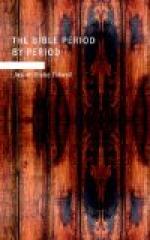Outline of The Narrative. The Scripture narrative falls into the following well-defined divisions: (1) An introduction or the condition in Palestine at the beginning of the period, Jud. 1:1-3:6. (2) The Judges and their work, Jud. 3:1:1-3:6. (2) The Judges and their work, (Jud. 3:7-16 end). (3) Micah’s idolatry, Jud. Chs. 17-18. (4) The crime of Gibeah, Jud. Chs. 19-21. (5) The story of Ruth, Ruth. (6) The career of Samuel including the judgeship of Eli, 1 Sam. Chs. 1-7.
Ethical and Religious Standards. Since this is a transitional period we may expect great difference of moral and religions standards. Some things are stressed far beyond their importance while other matters of more consequence are overlooked. The following examples will indicate to what extremes they went in some matters. (1) Some things bad: (a) Murdering a heathen enemy was counted a virtue; (b) It was not a crime to steal from a member of another Hebrew tribe; (c) Might was right; (d) They would keep any foolish vow to God even though it cost the life of one’s child as in the case of Jephthah. (2) Some things good: (a) The marriage relation was held sacred; (b) A covenant was held binding and sacred as in the case of the Gibeonites; (c) They counted inhospitality a crime. (3) Some strange inconsistencies: (a) Micah would steal his mother’s silver, then rear a family altar to Jehovah; (b) Samson would keep his Nazarite vow, preserve his hair intact and abstain from wine and unclean food but give himself over to lying and to his passions, and selfish inclinations and fail to observe the simple laws of justice, mercy and service.
Lessons of the Period. (1) As to national decay: (a) It is caused by religious apostasy; (b) It evidences itself in religious blindness, political folly and social immorality; (c) Its curse results in political and social disorder, chaos and ultimate ruin. (2) As to punishment for sin: (a) He surely sends punishment on the offender whether an individual or a nation; (b) His punishment is a matter of mercy and is intended to prepare the way for deliverance. (3) As to deliverance: (a) It never comes until repentance is manifested; (b) It is always through a deliverer whom we can not find but whom God must raise up for us. (4) From the book of Ruth it is shown that circumstances neither make nor mar believers.
For Study and Discussion. (1) The names of the Judges in order with the length of time each served or the period of rest after the work of each. (2) The enemy each judge had to combat. (3) What each judge accomplished against the enemy and what weapon he used-an oxgoad or what? (4) The elements of strength and weakness in the character of the principal men of the period. (5) The New Testament truths illustrated in the life and work of Gideon and Samson. (6) The lessons of practical life illustrated by the stories of Jephthah and Deborah. (7) The facts of the story of Micah and Gibeah. (8) The career of Samuel as found so far. (9) The value of a trusting soul as seen in Ruth. (10) The main element in their religion. (11) The condition of Israel at the beginning and at the end of this period. (12) The subject of good and successful parents with bad and unsuccessful children. The importance they attached to the Ark of the Covenant.




